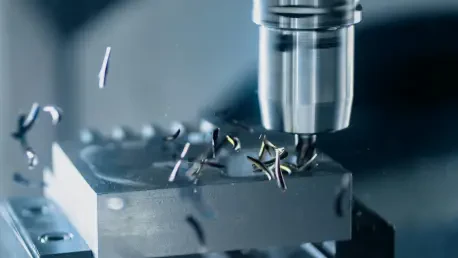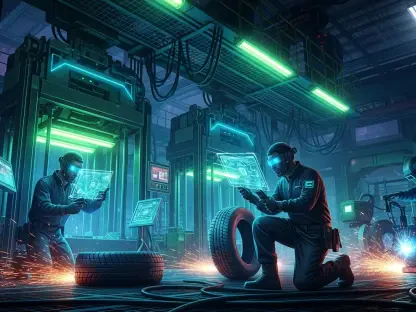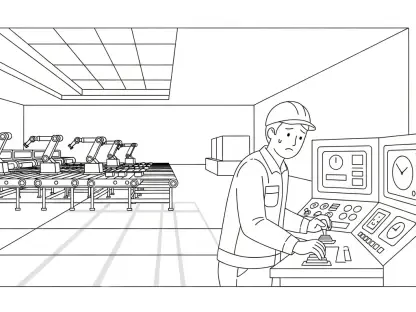Imagine a world where the smallest deviation in a manufactured part could lead to catastrophic failure in critical industries like aerospace or medical device production, where precision is not just a requirement but a lifeline. In such high-stakes environments, milling cutters emerge as the linchpins of CNC machining, ensuring that every cut is executed with razor-sharp accuracy. These tools, integral to Computer Numerical Control systems, shape raw materials into precise components by removing material with unparalleled control. Their role extends beyond mere cutting; they define the quality, efficiency, and reliability of the final product. From crafting intricate designs to smoothing vast surfaces, milling cutters are the backbone of modern manufacturing, meeting the stringent demands of today’s fast-paced industrial landscape. This deep dive explores how these specialized tools elevate precision, examining their diversity, material composition, selection criteria, and the technological advancements that continue to refine their capabilities.
Understanding Milling Cutters
Types and Their Unique Roles
Milling cutters come in an array of designs, each tailored to specific tasks that demand exacting precision in CNC machining. End mills, for instance, stand out with their ability to cut in multiple directions, making them ideal for creating slots, profiles, and detailed contours. Face mills, on the other hand, focus on producing flat surfaces across large workpieces, operating perpendicularly to remove material swiftly and uniformly. Ball nose cutters, with their rounded tips, excel at sculpting curved shapes, a critical need in industries requiring smooth, flowing geometries. Each type of cutter addresses a unique challenge, ensuring that manufacturers can achieve the desired outcome without compromising on accuracy. This diversity allows for adaptability across a spectrum of applications, from automotive parts to intricate electronic components, underlining the indispensable role of these tools in maintaining high standards of precision.
Another facet of milling cutters’ contribution to precision lies in their specialized functionalities for niche tasks. Side-and-face cutters, for example, offer dual cutting edges to handle complex operations like gear creation and slot milling with meticulous detail. Involute gear cutters are specifically engineered to shape gears, ensuring each tooth meets exact specifications for seamless mechanical performance. Hollow mills, with internal cutting teeth, tackle grooving and turning operations, while fly cutters manage shallow cuts on expansive surfaces with finesse. This range of tools ensures that no matter the complexity of the project, there is a cutter designed to execute the task with minimal deviation. Such precision is vital in CNC machining, where even a fraction of a millimeter can impact the functionality of the final product, reinforcing the importance of selecting the appropriate cutter for each unique manufacturing challenge.
Material Choices and Performance
The material composition of milling cutters plays a pivotal role in their ability to deliver precise results under varying conditions. High-speed steel (HSS) is a popular choice due to its resilience at elevated temperatures, making it suitable for high-speed operations without losing edge sharpness. Cemented carbides, known for their exceptional hardness, tackle tougher materials with ease, though they may crack under excessive stress. Carbon steel, while cost-effective, often falls short in durability for demanding tasks, wearing out quickly under intense use. Cutting ceramics, despite their extreme hardness, are brittle and prone to wear, limiting their application to specific scenarios. Choosing the right material ensures that the cutter maintains its integrity throughout the machining process, directly influencing the accuracy of cuts and the quality of the finished part.
Beyond durability, the material of a milling cutter impacts its compatibility with different workpieces, a key factor in achieving precision. For instance, HSS cutters are versatile enough to handle a range of metals at moderate speeds, ensuring consistent performance without frequent replacements. Cemented carbides, while more expensive, offer longevity when machining hard alloys, preserving the exactness of cuts over extended periods. The trade-offs between cost, toughness, and brittleness must be carefully weighed against project requirements to avoid tool failure mid-operation, which could lead to costly errors. This strategic alignment of cutter material with the specific demands of a task not only enhances precision but also extends tool life, reducing downtime and maintaining the tight tolerances required in CNC machining. The choice of material, therefore, is as critical as the cutter’s design in achieving superior manufacturing outcomes.
Factors in Tool Selection
Key Parameters for Precision
Selecting the right milling cutter involves a meticulous evaluation of several parameters that directly affect precision in CNC machining. Diameter is a primary consideration—smaller tools are adept at intricate detailing, allowing for fine cuts in tight spaces, while larger diameters excel at bulk material removal with efficiency. Coatings, such as titanium nitride, enhance tool life by minimizing wear and friction, ensuring consistent performance over time. Flute count determines how much material is removed per rotation, with higher counts enabling faster feed rates for smoother finishes. Helix angle also plays a role, as steeper angles are better suited for softer materials, optimizing chip evacuation. Balancing these factors ensures that the cutter performs at its peak, delivering cuts with exacting accuracy while maintaining speed and surface quality critical to high-standard production.
Another layer of complexity in achieving precision through tool selection lies in understanding how these parameters interact with specific project needs. For example, a cutter with a high flute count may speed up operations but could clog when machining sticky materials if not paired with an appropriate helix angle for effective chip removal. Coatings must be chosen based on the workpiece material to prevent premature wear that could compromise cut accuracy. A mismatch in diameter can lead to either inefficient material removal or damage to delicate features, underscoring the need for precise calibration. By aligning these technical aspects with the demands of the task, manufacturers can minimize variations in the machining process, ensuring that each cut adheres to design specifications. This careful selection process is fundamental to achieving the repeatability and precision that CNC machining promises in high-volume production environments.
Balancing Cost and Efficiency
The financial aspect of milling cutter selection cannot be overlooked, as it directly influences both precision and overall project viability. Opting for a high-end cutter with advanced coatings or premium materials like cemented carbide might increase upfront costs but can significantly reduce long-term expenses by extending tool life and minimizing replacements. Conversely, cheaper options like carbon steel may seem economical initially but often lead to frequent wear, resulting in inconsistent cuts and potential rework that drives up costs. Striking a balance between the initial investment and the expected performance ensures that precision is not sacrificed for the sake of budget constraints. This approach allows manufacturers to maintain tight tolerances without incurring unnecessary expenses, optimizing the machining process for both quality and affordability.
Efficiency in CNC machining also hinges on how well the selected cutter minimizes waste and downtime, further impacting precision. A poorly chosen tool might cause excessive vibration or heat buildup, leading to dimensional inaccuracies and material defects that require additional processing to correct. In contrast, a cutter tailored to the specific material and operation can execute cuts with minimal resistance, preserving the integrity of the workpiece and reducing scrap. This not only enhances the accuracy of the final product but also streamlines production timelines, ensuring that resources are used effectively. By prioritizing cutters that align with project goals—factoring in both performance capabilities and cost implications—manufacturers can achieve a harmonious blend of precision and efficiency, ultimately delivering components that meet exacting standards without straining budgets.
Technological Advancements and Automation
Innovations in Cutter Design
Recent strides in milling cutter technology have significantly boosted precision in CNC machining by addressing the challenges of modern manufacturing demands. Advanced coatings, such as multi-layered composites, reduce friction and heat buildup, allowing cutters to maintain sharpness over longer periods even when tackling hard materials. Improved geometries, including optimized flute designs and variable helix angles, enhance chip evacuation and reduce vibration, resulting in smoother cuts and tighter tolerances. These innovations enable cutters to handle a broader range of materials—from tough alloys to delicate composites—without sacrificing accuracy. As industries push for more complex designs and faster turnarounds, such advancements ensure that milling cutters remain at the forefront of delivering high-quality results with unmatched precision.
Another critical aspect of these design innovations is their ability to adapt to evolving manufacturing needs, further enhancing precision. For instance, cutters with micro-geometries are now engineered to perform ultra-fine cuts, catering to industries like electronics where miniature components require exact specifications. Hybrid tools combining multiple cutting features reduce the need for tool changes, minimizing setup errors and maintaining consistency across operations. These cutting-edge designs not only improve the surface finish but also extend the operational life of the tool, ensuring sustained accuracy over high-volume runs. By integrating such technological breakthroughs, manufacturers can push the boundaries of what’s achievable in CNC machining, meeting stringent standards while keeping pace with the rapid advancements in industrial requirements.
Automation’s Role in Error Reduction
Automation stands as a cornerstone of precision in CNC machining, and milling cutters are central to this transformative process. When integrated with computer-guided systems, these tools operate under precise instructions, eliminating the variability often introduced by human intervention. This results in consistent cuts, as every movement is calculated and repeated with exacting detail, crucial for producing identical parts in large quantities. Errors such as misalignment or uneven pressure, common in manual operations, are virtually eradicated, ensuring that each workpiece meets design specifications. The synergy between milling cutters and automation thus creates a reliable framework for achieving the high accuracy demanded by industries where even minor deviations can lead to significant setbacks.
Furthermore, the role of automation in enhancing precision extends to the monitoring and adjustment capabilities it offers during machining. Advanced CNC systems can detect anomalies like tool wear or material inconsistencies in real-time, allowing for immediate corrections without halting production. Milling cutters, when paired with such technology, can maintain optimal performance by adapting to changing conditions, ensuring that precision remains uncompromised throughout long runs. This level of control also reduces the risk of defective parts reaching the assembly stage, saving time and resources. By leveraging automation, manufacturers can trust that milling cutters will deliver repeatable, high-quality results, reinforcing the reliability and efficiency of the entire machining process in meeting today’s rigorous industrial standards.
Future Pathways for Precision Enhancement
Reflecting on the journey of milling cutters in CNC machining, it’s evident that their evolution has been marked by a relentless pursuit of accuracy and efficiency. In the past, the focus was on diversifying cutter types and materials to meet varied manufacturing challenges, a foundation that paved the way for the sophisticated tools seen today. The integration of automation further refined this landscape, minimizing errors and ensuring consistency in every cut. These milestones, achieved through years of innovation, have solidified milling cutters as indispensable assets in producing high-quality components across critical industries.
Looking ahead, the path to enhancing precision involves embracing emerging technologies and refining selection strategies. Manufacturers are encouraged to invest in cutters with advanced coatings and geometries tailored to specific applications, ensuring optimal performance. Collaborating with tool experts to understand project-specific needs can streamline the selection process, reducing costs while maintaining quality. Additionally, staying abreast of automation advancements will be key to maximizing repeatability and minimizing defects. By adopting these forward-thinking approaches, the industry can continue to elevate the standards of CNC machining precision.









